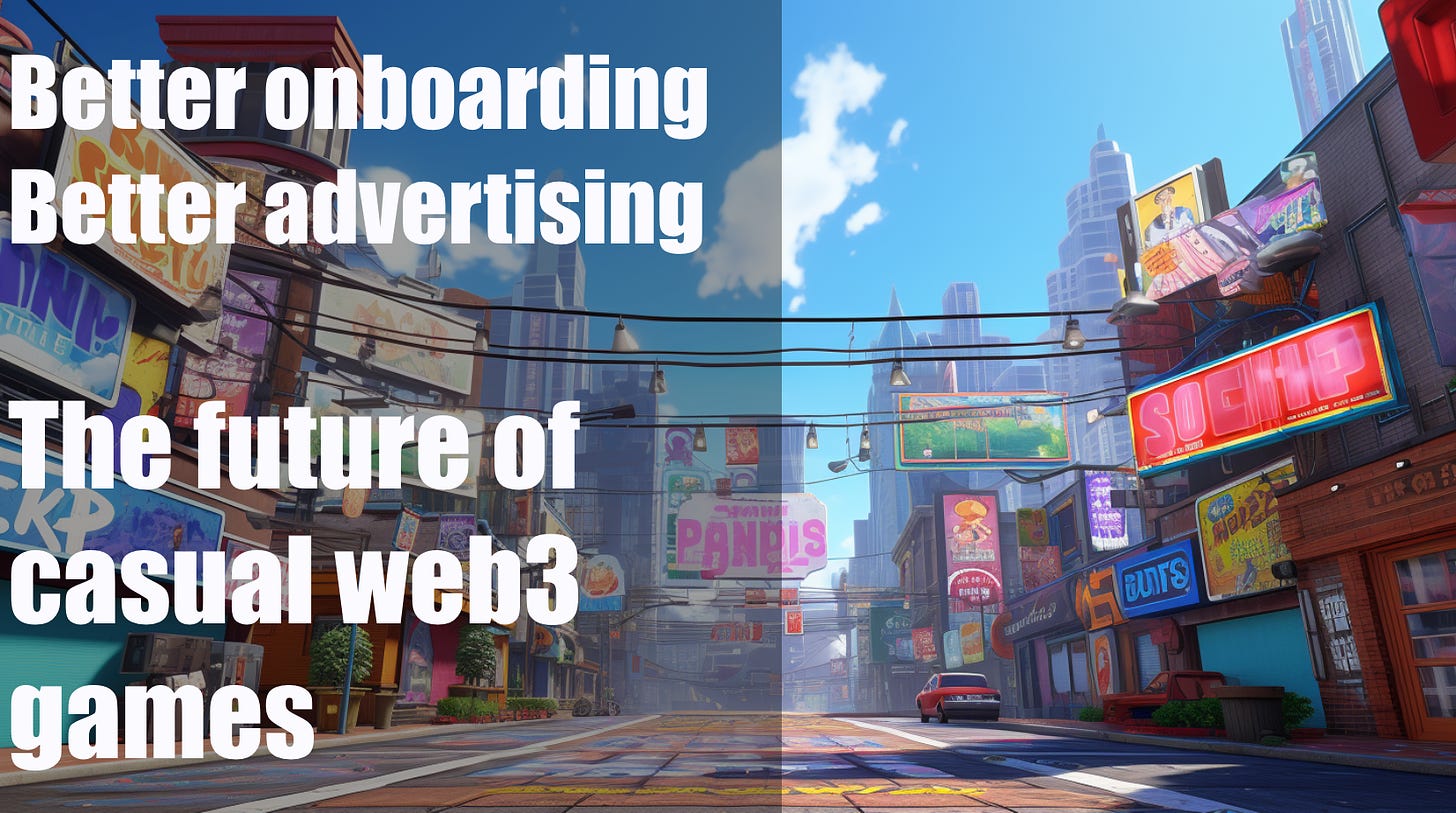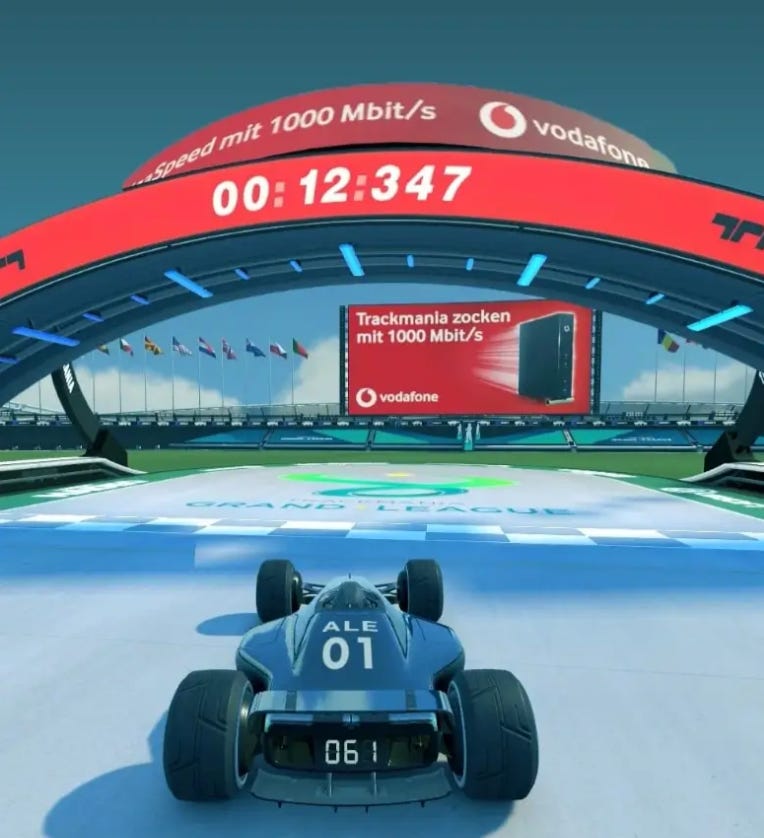Casual web3 games + in-game ads = good news
New tech opens up a sustainable future for accessible games
The first inning of web3 games was dominated by core gaming promises. Every studio launched with the notion of making AAA titles, even though these are the hardest games to build and the costliest to market. But they weren’t entirely wrong in their attraction to core PC and console gamers: these audiences tend to be higher spending than casual (especially mobile) players and are also more early-adopter-y and tech savvy. Good attributes in a consumer that needs to go through expensive and arduous onboarding.
The absence of most AAA publishers going into web3 in those early days also led folks to think there was a gap in the market for a brand new core game, despite the fact that all but one of the top 13 console games in 2022 were sequels or based on existing IP.
But there are two trends—ease of onboarding and better in-game advertising—converging on what I think is a massive, untapped opportunity in the blockchain games space: casual games.
Onboarding
First, the obvious: it’s getting easier than ever to onboard users into web3. The hoops to jump through for those first “core” web3 game consumers were multi-day and painful. With account abstraction and fiat on-ramps, players can now join and buy-into web3 games more or less as easily as connecting with a social login.
This is vital for casual games: the average session length is 5-7 minutes (vs 1-2 hours for many console gamers) and the average consumer skews older (social casino games were played primarily by middle-aged women). Being able to get a user in easily and buying quickly is crucial.
With smoother onboarding, the potential for reaching crypto-naive players suddenly opens up. A currently untapped audience for web3, which has spent years spending in games like Zynga Poker without ever being able to extract, or at least earn back, some of their losses. Approaching that crowd with the potential to get back some of that money could be huge.
The casual market
Casual games have a lot going for them:
They’re relatively cheap to make (a solo dev can bang out FlappyBird in three days vs. $80M for an average AAA title)
They can be distributed on any platform (including browser or social platforms, which are easier for integration with web3 tech right now)
They’ve got a bright future with $25B in revenue forecasted by 2027
Many of the so-called AAA web3 games will never see the light of day because the teams underestimated the amount of money and time needed to get those out the door. But casual games can be produced quickly, and have the added bonus of a huge and diverse addressable market. A mobile-first, browser-based game could theoretically be played by any of the 6.84B smartphone owners.
The issue, though, is that casual games don’t monetize particularly well, with low ARPPUs and a conversion rate amongst the lowest of all game categories at ~1%. Developers need to score massive audiences and figure out water-tight monetization triggers, tough models for sustainability, particularly with a fickle audience that jumps from game to game quickly.
Web3 already offers benefits to casual game devs in the form of higher LTV, ensuring that those 1-in-a-100 converting players provide more value, longer.
But what do you do with the other 99%?
In-game ads
Advertising in-game used to suck. Banner ads, interstitials ads: Ugly, obtrusive, and lose-lose for advertisers who wouldn’t get much in traffic and devs who had to muddy the look and feel of the game with blatant adverts that took players out of fun loops and looked entirely unlike any of the game art. A jarring experience. Just trash.
But ad-supported revenue models are important, especially for casual games, who need to balance CPI with that 1% spend rate. They end up with a lot of eyeballs, and need to do something with them.
The in-game ad tech world has changed considerably in recent years. Brands figured out that gaming’s 3B players were extremely valuable and worth investing major ad dollars into, and new companies sprouted to make the experience more native. Folks like Overwolf (whose primary business is UGC but who has processed $50M of in-game incremental revenue for devs) and Anzu let developers build ad real estate into the game. For example, racing cars, which have corporate logos on them IRL, serve as the canvas onto which ads can be inserted and swapped out easily, without the developer spending extra time to get new logos. Avatars can have branded tattoos, billboards can be filled with dynamic spots. It all happens without disruption to the gameplay. And data show that gamers look at integrated game ads twice as long as they do other kinds. Better engagement = better ad revenue.
Casual games, in some ways, are even better suited for in-game ads than more immersive gameplay. Super short session lengths on devices that are more likely to have usable browsers (a mobile phone vs a console) means that users can more easily follow an ad link and convert than a player that’s 20 minutes into a two-hour single-player PS5 epic.
And don’t just take my word for it, in-game advertising has a healthy looking future: $20B by 2032.
What’s next
If you poke around, the casual dev crowd is starting to see potential in web3. Like Eyeball Games, who plan to create a new version of their old 10M DAU pool game on Immutable. While they’re focused on no ads and essentially pay-to-play mechanics as of now (with pre-launch access NFTs), I can see how seamless in-game ads could be added to the pool table border, cues, or balls. Or AQUA, who launched three casual games earlier this year, including ludo and solitaire (card-back ads, anyone?).
The skewed core-gamer start of web3 gaming was never going to “onboard the next billion.” That always required not only seamless tech, but also the types of accessible games most people play. Since many of those games will naturally be unsustainable with purely F2P economies, developers will have to think of what to do with the rest of that audience segmentation. For years, that meant low-rent ads, but new tech will deliver better experiences for brands, developers, and players.
And this is to say nothing of how ads could play a role in dynamic in-game NFTs, a powerful advertising domain unique to the blockchain world.
Till then, who’s got a dominos game for me?





